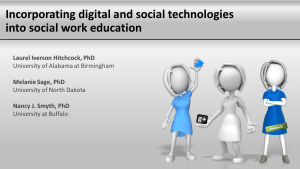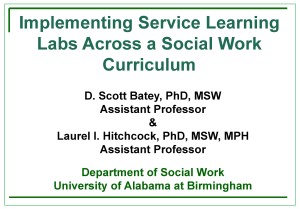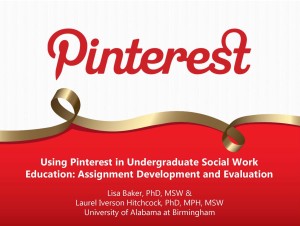#SWDE2016 Incorporating Digital & Social Technologies into Social Work Education
 Today is the Day 1 of the Second Annual Social Work Distance Education Conference, and I am lucky enough to be presenting with Drs. Melanie Sage (University of North Dakota) and Nancy J. Smyth (University of Buffalo, SUNY) about how to incorporate digital and social technologies into social work education. Our workshop will inform participants about the mechanics as well as the advantages and disadvantages of incorporating digital and social technologies assignments into social work courses. Topics to be covered include the importance of digital literacy and how to use theory to inform the integration of technology into their online courses. Participants will learn about example assignments and learning activities for social work courses that incorporating digital and social media such as microblogging, designing infographics, and creating a video. By the end of the workshop, participants will:
Today is the Day 1 of the Second Annual Social Work Distance Education Conference, and I am lucky enough to be presenting with Drs. Melanie Sage (University of North Dakota) and Nancy J. Smyth (University of Buffalo, SUNY) about how to incorporate digital and social technologies into social work education. Our workshop will inform participants about the mechanics as well as the advantages and disadvantages of incorporating digital and social technologies assignments into social work courses. Topics to be covered include the importance of digital literacy and how to use theory to inform the integration of technology into their online courses. Participants will learn about example assignments and learning activities for social work courses that incorporating digital and social media such as microblogging, designing infographics, and creating a video. By the end of the workshop, participants will:
1. Understand the importance of digital literacy in 21st century social work practice.
2. Demonstrate how digital and social technologies can be incorporated into assignments for social work courses.
3. Appreciate the role of theory to support the development and implementation of technology-based assignments.
Here is a link to the slides from the workshop: https://www.slideshare.net/secret/8jgUUNwPcTPt46.
We also shared the following handout: Technology-Based Learning Task List for Social Work Education.
Review of #BPDTX16
I spent five days in Dallas last week (3/30/16-4/3/16) at the 2016 Annual Program Meeting for the Association of Baccalaureate Program Directors, one of my favorite social work conferences. My good colleague, Dr. Jimmy Young of California State University – San Marcos, wasn’t able to attend this year’s conference, but wrote a blog post about the pre-conference workshop we worked on with Dr. Stephen Baldridge of Abilene Christian University. As a member of the BPD Technology Committee, I spent most of my time at sessions from the Technology Track. Here are some of the sessions I attended and tweeted about during the conference:
– Dr. Becky Anthony & Ms. Jennifer Jewell from Salisbury University presented on A Social Media How-To Guide for BSW Educators – This interactive workshop explores research and best practices to help educators understand how to utilize social media in their courses and departments. Pros, cons, and goals will be discussed. Also, a student perspective will be reviewed. Attendees are encouraged to share their own experiences and strategies.
– Dr. Thomas Felke from Florida Gulf Coast University presented on Revealing Patterns, Improving Service Delivery, and Empowering Communities: GIS for Social Work – Social work students and practitioners armed with GIS technology can better understand community needs, measure environmental forces, and improve service delivery. However, few social work departments nationwide offer GIS courses. This session introduces participants to GIS uses within social work and provides real-world examples of social work applications of GIS.
– Dr. Melanie Sage & Mr. Todd Sage from the University of North Dakota presented on Professional Online Identities for Students and Faculty – In today’s internet-reliant culture, a prospective meeting with a social worker or faculty member is often preceded by an internet search. Social workers have the opportunity to shape their professional online identities. Tools and resources are presented to help social work educators support students in developing online identities. Here is a link to a blog post about their presentation.
Here is a link to a Storify transcript I created of tweets from the conference. You’ll see my tweets about each of these sessions as well tweets from other social work educators. Also, here are links to blog posts about my three presentations at the conference:
Social Media and Technology Basics for the Social Work Educator
Using Pinterest in Undergraduate Social Work Education
Service Learning Labs: Integrating experiential learning across a BSW Curriculum
How to cite this post:
Hitchcock, L. I. (2016, April 9). Review of #BPDTX16 [Blog Post]. Retrieved from https://laureliversonhitchcock.org/2016/04/09/review-of-bpdtx16/.
Service Learning Labs: Integrating experiential learning across a BSW Curriculum – #BPDTX16
 Day 4 of #BPDTX16 for me and my last presentation will be at 9:30 AM today. I will be talking about the work I have been doing with my colleague, Dr. Scott Batey, along with many other partners at UAB and in the Birmingham community. Unfortunately, Scott was not able to attend BPD this year, but he feels confident I won’t mess up the presentation. For our session, we really wanted to highlight the development of service learning labs in our BSW curriculum as a case study, hopefully offering tips and ideas for others wanting to incorporate more service learning into their assignments, courses & curricula.
Day 4 of #BPDTX16 for me and my last presentation will be at 9:30 AM today. I will be talking about the work I have been doing with my colleague, Dr. Scott Batey, along with many other partners at UAB and in the Birmingham community. Unfortunately, Scott was not able to attend BPD this year, but he feels confident I won’t mess up the presentation. For our session, we really wanted to highlight the development of service learning labs in our BSW curriculum as a case study, hopefully offering tips and ideas for others wanting to incorporate more service learning into their assignments, courses & curricula.
Here are the learning objectives for the session:
1. Understand how to plan and engage multiple partners in developing a curriculum-based service learning project to support student and community outcomes.
2. Determine how educators can duplicate the planning process for curriculum-based service learning projects at their own institutions.
3. Appreciate the role of professional collaboration in the planning and development of service-learning projects across a curriculum.
You can access a copy of the slides here: https://www.slideshare.net/secret/5GRJ7Qx3hVLzuG
Using Pinterest in Undergraduate Social Work Education – #BPDTX16
 March 31st will be Day Two for me at #BPDTX16 and I will be presenting on how Pinterest can be incorporated into undergraduate education. My UAB colleague, Dr. Lisa Baker, and I developed and implemented a social media-based assignment using Pinterest in our HBSE course sequence last year. Even though Lisa won’t be able attending BPD this year, I’m looking forward to talking about this assignment and our assessment outcomes. The session is from 11:15 AM-12:30 PM in Majestic 4 on 3/31/16.
March 31st will be Day Two for me at #BPDTX16 and I will be presenting on how Pinterest can be incorporated into undergraduate education. My UAB colleague, Dr. Lisa Baker, and I developed and implemented a social media-based assignment using Pinterest in our HBSE course sequence last year. Even though Lisa won’t be able attending BPD this year, I’m looking forward to talking about this assignment and our assessment outcomes. The session is from 11:15 AM-12:30 PM in Majestic 4 on 3/31/16.
We will focus on how practitioners are increasingly using social media to interact with client systems. As such, educators and students should recognize the role social media plays in developing practice related competencies and connecting to a larger learning network. Our workshop presents the development, implementation and evaluation of Pinterest assignments in undergraduate education.
Learning objectives for this session include:
1. Participants will explore the use of Pinterest as a teaching tool in undergraduate courses, following an evidence-based model of assignment development, implementation and evaluation.
2. Participants will become aware of the context in which students complete social media assignments and the role social media plays in helping students develop professional self.
3. Participants will discuss caveats to developing social media assignments and learn how such assignments help develop practice competencies.
Here is a link to the slides from the presentation: Using Pinterest in Undergraduate Social Work Education Slides on SlideShare.
Also, you can download the two rubrics from the presentation here:


